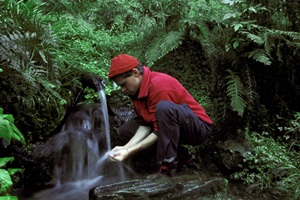Whether you find yourself in a disaster situation, which as we learned from super storm Sandy can happen at anytime, or are just enjoying camping out in the wilderness far from modern conveniences, having access to pure water is a vital necessity. We can survive for weeks without food, but only for a few days without water. Even if you are surrounded by it, it is possible to be in a situation where ingesting it may be a dangerous prospect. As the saying goes, “water, water everywhere, but not a drop to drink.” Untreated water may contain disease-causing bacteria that can cause severe vomiting, diarrhea and sometimes death. If you do not have bottled water handy but you have access to a water source, we will provide here, the tools you need to make it safe to drink, whether at home or on the go. 
Boiling
The simplest method of purifying water is to boil it, particularly if you are at home and have access to a working stove. This will rid the water of any viruses or bacteria that can cause serious illnesses, particularly to children, the elderly and those with compromised immune systems. Diseases such as Giardia, Cryptosporidium, dysentery and hepatitis can be contracted through drinking contaminated water. Pour the water into a clean heatproof vessel and boil it for a minimum of five minutes to ensure that all the pathogens are killed. The water will have a flat taste due to the oxygen having been boiled out of it, but this can be reintroduced by pouring it back and forth between two vessels or simply shaking it up in a closed bottle.
Chemical Purification
Pharmacies sell water purification products that consist of chemicals that will destroy harmful microorganisms. They are available either in liquid or tablet form and contain chemicals such as iodine, potassium permanganate, chlorine and halazone. Use two drops or tablets per quart of water and wait at least 30 minutes before you drink it. Iodine can leave an unpleasant taste in the water, which can be removed with the addition of some vitamin C (ascorbic acid). However, this should be added only after the iodine has been allowed to do its work, as vitamin C interferes with the action of iodine. A couple of drops of regular household bleach per quart of water will also work in a pinch, just be sure the bleach is less than a year old, as it degrades with time and old bleach may not be sufficiently effective. Be sure never to use “color safe” or scented bleach.
Filters
A portable hand-held water filter is especially handy if you’re on the go. Look for a filter with a pore-size efficiency less than 0.4 microns in order to remove bacteria as well as protozoa such as Giardia and Cryptosporidium. Unless you buy the EPA-certified First Need water filter manufactured by General Ecology (which is expensive), your filter should also include some chemical purification such as iodine to kill any viruses that may be present in the water. This is particularly important if you are traveling in countries in which water contamination from raw sewage is a danger.
Whichever method you choose, it pays to purify any water you drink. It may take some time, but staying healthy and disease-free is definitely worth the effort. Learn more about your overall health by visiting us!
Chicago Chiropractic
A Unique, Multidisciplinary Approach to Pain Management
X
